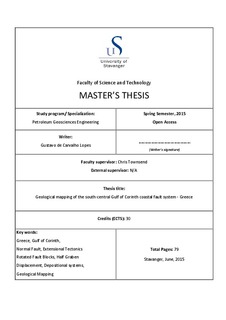| dc.contributor.author | Lopes, Gustavo de Carvalho | |
| dc.date.accessioned | 2015-09-17T08:39:07Z | |
| dc.date.available | 2015-09-17T08:39:07Z | |
| dc.date.issued | 2015-06 | |
| dc.identifier.uri | http://hdl.handle.net/11250/300414 | |
| dc.description | Master's thesis in Petroleum geosciences engineering | nb_NO |
| dc.description.abstract | This thesis is related to geological mapping of the south-central Gulf of Corinth (Greece), providing an interpretation for the major fault systems towards the east and the west of much studied coastal fault segments: Eghio, Eliki, Mamousia and Pirgaki.
The Corinth Rift is the focus of numerous studies witch are typically centered on key locations and relate to active coastal faults and syn-rift sediments. A structural framework that allows for data integration is of great importance, however regional structural studies have considerable impediments as fault scarps are frequently affected by erosional processes or covered by syn-rift sediments.
It is the main intention of this thesis to describe faults while investigating regional connectivity, linkage and continuity. Detailed descriptions of depositional systems are available on the literature, hence field observations intend only to aid fault characterization and contribute for an integrated regional perspective.
Field work covered over 1300 km2, produced 312 observation points with over 500 field measurements. Over the course of 17 days, field activities strived to map and describe faults while observing lithological changes and comparing field data with literature information. Multispectral satellite compositions were designed for the purpose of geological and geomorphological compartmentalization, while gravimetric datasets and digital elevation models supported field mapping and discussions.
The regional scope of field mapping with the occasional impracticality of field observations, added to the different scales and uneven distribution of literature were major obstacles for this project. Nonetheless major fault zones have been defined as composed of multiple unaligned segments up to 10 kilometers long that connect over soft and hard linked structures to develop regional trends. These trends extend for up to 50 kilometers on a predominant S75°E direction and present lower displacement trend west and northwards. Segments have brittle fault damage zones up to 100 meters wide containing discrete fault surfaces marked with slickensides that suggest a mix of normal and oblique slip. The average of displacements estimates is 1530 meters with maximum 4700 and minimum at 230. Fault development in the region is an important factor controlling syn-rift depositional systems where modern examples can be used to predict expected patterns on older units in the study area. | nb_NO |
| dc.language.iso | eng | nb_NO |
| dc.publisher | University of Stavanger, Norway | nb_NO |
| dc.relation.ispartofseries | Masteroppgave/UIS-TN-IPT/2015; | |
| dc.rights | Navngivelse-Ikkekommersiell 3.0 Norge | * |
| dc.rights.uri | http://creativecommons.org/licenses/by-nc/3.0/no/ | * |
| dc.subject | Gulf of Corinth | nb_NO |
| dc.subject | structural geology | nb_NO |
| dc.subject | normal fault | nb_NO |
| dc.subject | petroleumsgeologi | nb_NO |
| dc.subject | depositional system | nb_NO |
| dc.subject | displacement | nb_NO |
| dc.subject | extensional tectonics | nb_NO |
| dc.title | Geological mapping of the south-central Gulf of Corinth coastal fault system - Greece | nb_NO |
| dc.type | Master thesis | nb_NO |
| dc.subject.nsi | VDP::Technology: 500::Rock and petroleum disciplines: 510::Geological engineering: 513 | nb_NO |
| dc.subject.nsi | VDP::Mathematics and natural science: 400::Geosciences: 450::Petroleum geology and petroleum geophysics: 464 | |
| dc.subject.nsi | | |
| dc.source.pagenumber | 79 | nb_NO |

